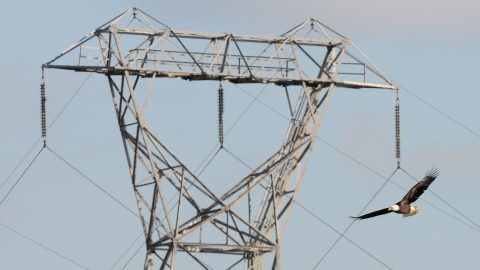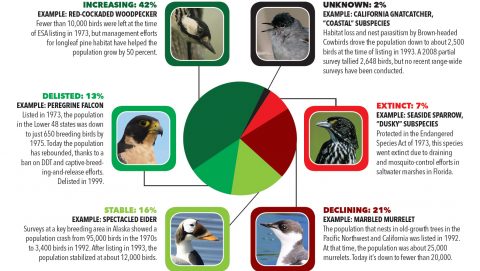Analysis: Failing To Invest In Endangered Species Is A Tragedy Of The Commons
By John W. Fitzpatrick
June 13, 2018From the Summer 2018 issue of Living Bird magazine. Subscribe now.
Exactly 50 years ago, University of California, Santa Barbara, ecologist Garrett Hardin popularized a crucial dilemma about how society manages shared resources. In a philosophical essay entitled “The Tragedy of the Commons,” published in the journal Science, Hardin’s now-famous paradigm imagined the example of a pastoral community where individuals graze their privately owned livestock on the public “commons.” Each owner can gain income by adding to the size of his herd, but ultimately this causes the entire commons to degrade and collapse from overgrazing. Everybody loses. This conceptual dilemma applies generally to any resource-based system in which individuals acting selfishly can destroy the common good for everyone, by depleting or ruining the shared resource on which the whole community depends. Hardin’s essay continues to stimulate thoughtful debate at the intersection of economics, philosophy, politics, and environmental policy.
Hardin’s focal tragedy implicitly underlies almost every discussion about biodiversity conservation. While his primary attention centered on managing human population growth, his prescient essay also alluded to resource-management examples that remain even more relevant today. Open-ocean fisheries are being depleted at an accelerating pace. Underfunded national parks are compromised by unruly crowds and anthropogenic noise. Ecosystems are being degraded by pollution and exploitation, at both individual and industrial scales. As Hardin phrased it half a century ago, we are “locked into a system of ‘fouling our own nest’ so long as we behave only as independent, rational, free-enterprisers.”
During the five years immediately following Hardin’s essay, the United States established an extraordinary series of new agencies, federal laws, and regulatory procedures designed essentially to thwart the tragedy of the commons. Chief among these actions were the formation of an Environmental Protection Agency and National Oceanic and Atmospheric Administration, along with passage of the National Environmental Policy Act, Clean Water Act, Marine Mammal Protection Act, and arguably the most far-reaching of all—Endangered Species Act (ESA).

The ESA was signed in 1973 by a conservative, pro-business, anti-regulation president, Richard M. Nixon. It had been championed by several of Nixon’s senior staff, including his chief domestic advisor, John Ehrlichman—the Eagle Scout, outdoorsman, and avid bird watcher who would later serve prison time for his role in the Watergate cover-up. The ESA would be the last of the great environmental achievements of the Nixon Administration.
The ESA is at once both elegant and ambitious, committing the federal government to doing everything within its authority to prevent any species within U.S. jurisdiction from going extinct, as well as conforming to international restrictions on wildlife trade. All key sections of the act are grounded in science. Too often overlooked is the explicit opening phrase of Section 2(b): “The purposes of this Act are to provide a means whereby the ecosystems upon which endangered species and threatened species depend may be conserved…” These essential words express an overarching truth about endangered species—they are not arbitrary elements of nature that deserve our investment just because they exist. Rather, they represent alarm bells that signal imbalance, degradation, or impending loss of our nation’s priceless natural ecosystems. Viewed under this light, the ESA represents an essential commitment by our federal government to safeguard—and as necessary, invest in, the commons.
More On U.S. Bird Conservation Policy
The ESA came under attack almost immediately, especially as the economic implications of protecting biological systems from rampant development became clear. Practical amendments passed in 1978, 1982, and 1988 provided latitude for exceptions and permitting based on habitat conservation planning. Like the original act, these amendments strongly affirmed the role of science in determining listing status and granting permits to “take” endangered species. Courts have repeatedly upheld the ESA as constitutional, and have affirmed the biologically grounded principle that habitat destruction can constitute illegal harm to an endangered species.
Until recently, complaints and legal battles surrounding endangered species management have centered on contentions that the ESA constrains business and infrastructure development, adds unbearable costs for real estate developers and farmers, shrinks venerable industries such as old-growth timber-harvesting, and violates personal freedoms. ESA advocates respond by observing that safeguarding the earth’s natural heritage for future generations to use and experience is a societal responsibility. In this context, no price is too high. Regulations that constrain free-enterprise behavior in order to prevent species extinctions are essential for battling the otherwise inevitable—here it comes again—tragedy of the commons.
Can The Endangered Species Act Succeed At Current Funding Levels?
Now a new, controversial twist has emerged in the endangered species debate, and ironically its proponents, including many ecologists, are pro-conservation and staunchly in favor of a strong ESA. At issue is how federal agencies are deciding to direct their limited resources toward recovering endangered species. Backers of the new approach argue that because public funding for endangered species is so tight, and only getting tighter, explicit decision rules and “conservation triage” are essential in order to improve results. They propose that resource allocations would result in more successes if they followed objectively derived algorithms incorporating variables such as projected cost of recovery, likelihood of success, degree of threat, and value of the conservation target.
At least three crucial assumptions underlying the algorithm-and-triage approach to endangered species management stand out as especially dubious. First, available resources are constrained to remain tiny with respect to the overall need. Second, accurate data are available for all the variables feeding the algorithm. Third, relative values of the full list of endangered species can be assigned by consensus or can be objectively derived.

The second and third of these assumptions are demonstrably false. For example, almost all of the recovery plans on which to base these classifications are decades out of date (more than 70 percent of ESA recovery plans are more than 20 years old), and their listed recovery budgets are meaningless. Regarding relative values of the targets, as the ESA declares, every one of the listed species represents an indicator of an ecosystem gone awry. Given our commitment to the commons, on what objective criteria does one ecosystem warrant more investment than another? Those who love mossy old-growth forests and Marbled Murrelets will argue for disproportionate investment there, while others favoring the diminutive plants of Florida scrub ecosystems will rate those habitats higher.
The first of the algorithm-and-triage assumptions—constrained resources—is the most important, least defendable, and in the long run, most dangerous. The requested $11.7 billion 2019 budget of the U.S. Department of the Interior allocates a paltry $81 million for endangered species recovery, while devoting billions of dollars to agencies and operations that facilitate resource extraction from federal lands. Where are our priorities as a nation to protecting our commons?
Year in and year out, we allocate vastly more resources to outer space than we do to the well-being of our country’s embattled living systems. (The requested 2019 budget for NASA alone is $19.9 billion, fully 70 percent higher than Interior’s entire budget.) Both the Obama and Trump administrations have advocated investing in sending humans to Mars, the cost of which is highly uncertain but sure to exceed $100 billion, and by some estimates could reach $1 trillion over 25 years!
Comparisons such as this can be made over and over again across the entire federal budget. That these comparative expenditures purport to express our national priorities cannot be overstated, and when it comes to the all-important question here—how much should we invest in our commons?—the numbers are nothing short of disgraceful. Our precious ecosystems demand much more from us if we as a nation are to have any hope of remaining proud of our landscapes from sea to shining sea.
When it comes to priority-setting regarding recovery of these ecosystems and their flagship endangered species, deriving algorithms and promoting conservation triage miss the point entirely. Worse, wrapped under the guise of rational decision making, they provide defense and cover for the status quo.
Meanwhile, our precious commons succumb bit by bit to the tragedy.

All About Birds
is a free resource
Available for everyone,
funded by donors like you
American Kestrel by Blair Dudeck / Macaulay Library






